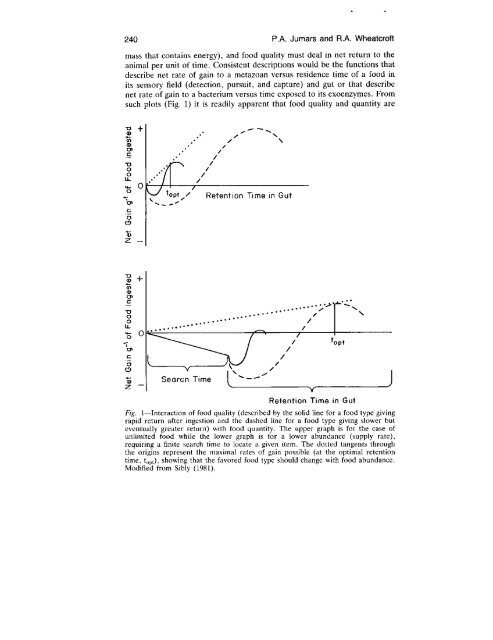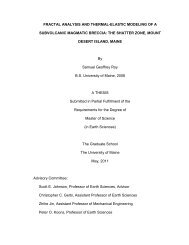Responses of Benthos to Changing Food Quality and Quantity, with ...
Responses of Benthos to Changing Food Quality and Quantity, with ...
Responses of Benthos to Changing Food Quality and Quantity, with ...
You also want an ePaper? Increase the reach of your titles
YUMPU automatically turns print PDFs into web optimized ePapers that Google loves.
240 P .A. Jumars <strong>and</strong> R .A . Wheatcr<strong>of</strong>t<br />
mass that contains energy), <strong>and</strong> food quality must deal in net return <strong>to</strong> the<br />
animal per unit <strong>of</strong> time . Consistent descriptions would be the functions that<br />
describe net rate <strong>of</strong> gain <strong>to</strong> a metazoan versus residence time <strong>of</strong> a food in<br />
its sensory field (detection, pursuit, <strong>and</strong> capture) <strong>and</strong> gut or that describe<br />
net rate <strong>of</strong> gain <strong>to</strong> a bacterium versus time exposed <strong>to</strong> its exoenzymes . From<br />
such plots (Fig . 1) it is readily apparent that food quality <strong>and</strong> quantity are<br />
v +<br />
m<br />
N m<br />
CC<br />
0<br />
tL<br />
o- 0<br />
0<br />
C<br />
<strong>to</strong>ot /<br />
Retention Time in Gut<br />
C<br />
0<br />
0<br />
m<br />
z -<br />
Search Time<br />
Retention Time in Gut<br />
Fig. 1-Interaction <strong>of</strong> food quality (described by the solid line for a food type giving<br />
rapid return after ingestion <strong>and</strong> the dashed line for a food type giving slower but<br />
eventually greater return) <strong>with</strong> food quantity . The upper graph is for the case <strong>of</strong><br />
unlimited food while the lower graph is for a lower abundance (supply rate),<br />
requiring a finite search time <strong>to</strong> locate a given item . The dotted tangents through<br />
the origins represent the maximal rates <strong>of</strong> gain possible (at the optimal retention<br />
time, showing that the favored food type should change <strong>with</strong> food abundance .<br />
Modified from Sibly (1981) .
















